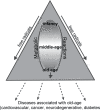Studies on free radicals, antioxidants, and co-factors
- PMID: 18044138
- PMCID: PMC2684512
Studies on free radicals, antioxidants, and co-factors
Abstract
The interplay between free radicals, antioxidants, and co-factors is important in maintaining health, aging and age-related diseases. Free radicals induce oxidative stress, which is balanced by the body's endogenous antioxidant systems with an input from co-factors, and by the ingestion of exogenous antioxidants. If the generation of free radicals exceeds the protective effects of antioxidants, and some co-factors, this can cause oxidative damage which accumulates during the life cycle, and has been implicated in aging, and age dependent diseases such as cardiovascular disease, cancer, neurodegenerative disorders, and other chronic conditions. The life expectancy of the world population is increasing, and it is estimated that by 2025, 29% of the world population will be aged > or = 60 years, and this will lead to an increase in the number of older people acquiring age-related chronic diseases. This will place greater financial burden on health services and high social cost for individuals and society. In order to acheive healthy aging the older people should be encouraged to acquire healthy life styles which should include diets rich in antioxidants. The aim of this review is to highlight the main themes from studies on free radicals, antioxidants and co-factors, and to propose an evidence-based strategy for healthy aging.
Figures



References
-
- Agarwal RS, Sohal RS. Relationship between susceptibility to protein oxidation, aging, and maximum life span potential of different species. Exp Gerontol. 1996;31:365–72. - PubMed
-
- Agarwal S, Rao AV. Tomato lycopene and low density lipoprotein oxidation; a human dietary intervention study. Lipids. 1998;33:981–84. - PubMed
-
- Agil A, Durản R, Barrero F, et al. Plasma lipid peroxidation in sporadic Parkinson’s: Role of the L-dopa. J Neuro Scien. 2006;240:31–6. - PubMed
-
- Aksoy P, White TA, Thompson M, et al. Regulation of intracellular levels of NAD: A novel role for CD38. Biochem Biophys Res Comm. 2006;345:1386–92. - PubMed
-
- Alaluf S, Muir-Howie H, Hu HL, et al. Atmospheric oxygen accelerates the induction of a post-mitotic phenotype in human dermal fibroblasts: the key protective role of glutathione. Differentiation Res Biol Diversity. 2000;66:147–55. - PubMed
Publication types
MeSH terms
Substances
LinkOut - more resources
Full Text Sources
Other Literature Sources
Medical

